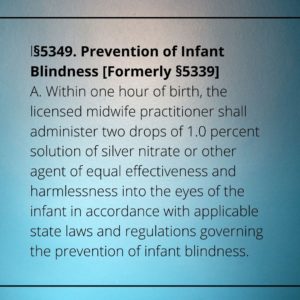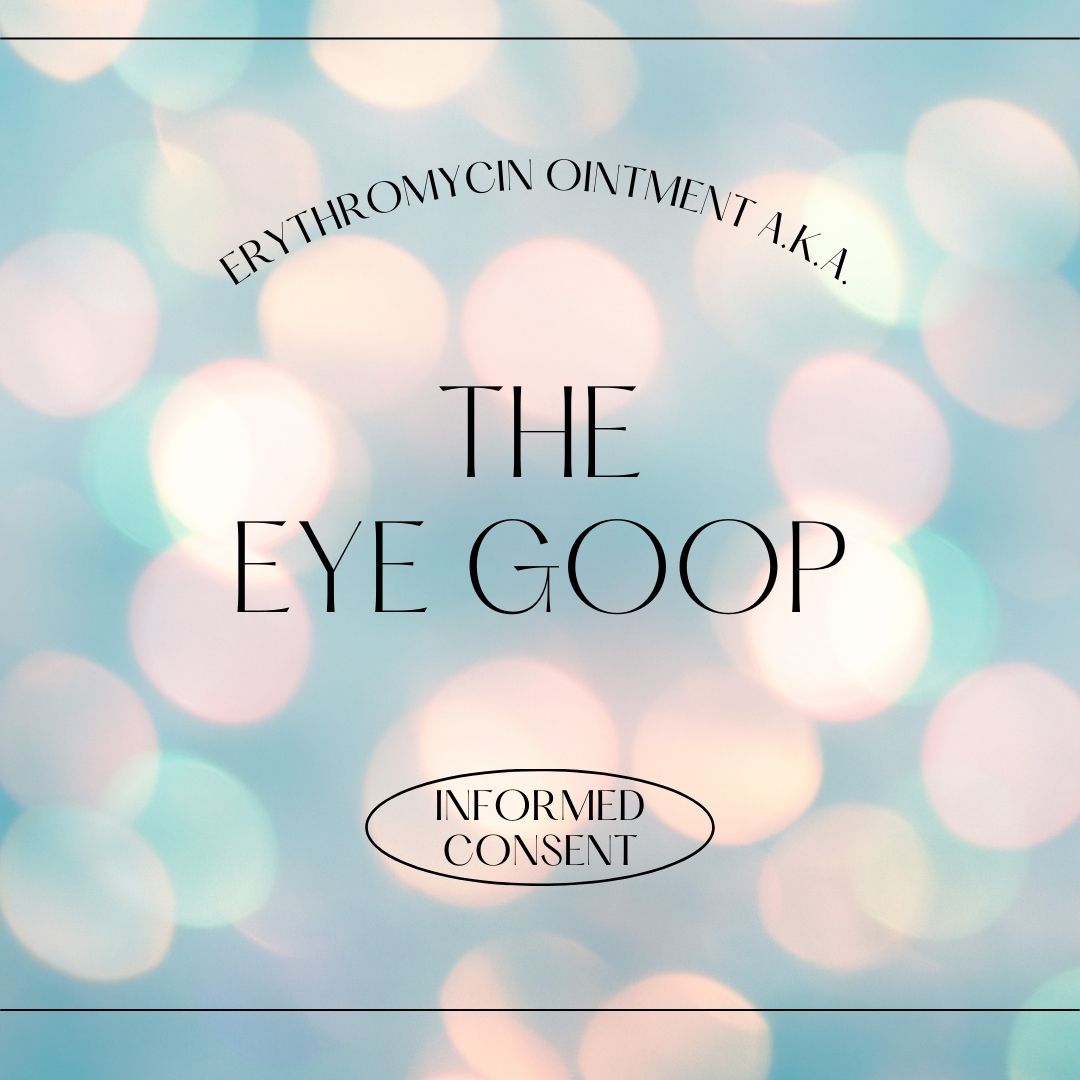Please read the disclaimer.
Many, many first pictures of newborns show them with a clear, Vaseline looking kind of ointment in their eyes. This “eye goop” is an antibiotic called Erythromycin. It protects the baby from different kinds of eye infections and from blindness in case the mother has Chlamydia and/or Gonorrhea and doesn’t know. The ointment does not burn the baby’s eyes, but it does make their vision blurry for about 30 minutes.
Let’s Back Up
People are tested for Chlamydia and Gonorrhea at their first prenatal appointment with their OB. When there is a positive results, the person and their partner(s) are easily treated with antibiotics. Knowing the statuses for Chlamydia and Gonorrhea are important because an untreated infection of most any kind can lead to premature labor. This blood test (one test is for both) is routinely done again (whether positive or negative at the first testing) at 36 weeks gestations during obstetrical care, and midwives offer it at that time. Again, it is routinely performed at the time of delivery with obstetrical care, and midwives offer it. However, that is a topic for “Routine Testing During Labor” in the future.
Some families choose midwifery care for its flexibility with client wishes and shared decision making process between client and care provider, and these families routinely decline any further STD testing during pregnancy as well as the eye ointment for their newborns at the time of delivery. They will say that they know they have a negative status because they are in a monogamous relationship, and refuse further testing and routine treatments as a badge of trust in their relationship. However, I want to point out that there are more than the infections from Chlamydia and Gonorrhea that can cause eye problems for the baby.
Wait! There’s More…
There are other less concerning eye infections than the blindness caused by STDs. Bacteria from maternal stool that passes during delivery may cause pink eye, especially, during a water birth. Other bacteria may cause conjunctivitis, or yellow matter it the eyes. Some bacteria can be transferred to the baby’s eyes during a cesarean delivery when there is a rupture of membranes (water brakes) prior to surgery.
Newborn eye infections are usually benign and go away on their own. Wiping the eye toward the inner corner with a warm wet cloth is usually all that is needed. Some want to treat with drops of breastmilk because of breastmilk’s antibodies. Antibodies are a specific antigen to a specific bacteria, not to be confused with an antibiotic that targets a broad spectrum of bacteria. I am not against using breastmilk to flush the eyes. However, I can find no evidence that it works better than sterile water. In fact, breastmilk may be more readily available than sterile water.
Why Would I? Why Wouldn’t I?
Some parents choose Erythromycin ointment for:
- security that their baby will not go blind from an undiagnosed case of Chlamydia or Gonorrhea in the mother at the time of birth
- prophylactic against other eye infections when the mother doesn’t breast feed or is uncomfortable with putting breastmilk in the newborn’s eyes
Some parents choose no Erythromycin ointment for:
- wanting the baby to see parents clearly during the “golden hour.”
- feeling it is unnecessary for their lifestyle
- preference for treatments of actual conditions only

Use Your BRAIN
I show my doula and childbirth education clients how to use the BRAIN in determining any healthcare related procedure. The use of erythromycin antibiotic in the newborn’s eye might look like this:
Benefit; prevents eye infections such as pinkeye and conjunctivitis, and blindness from undiagnosed Chlamydia infection in the mother
Risk; blurry vision for about 30 minutes
Alternative; use colostrum instead, wait and see and only treat infection if one occurs
Intuition; individual to each person
Not now; only effective in preventing blindness within the first hour after birth
The decision to have prophylactic “eye goop” for your baby is very personal. There are no right or wrong answers. Look at the evidence, take your time, and come to a decision that works best for your family.
For further reading on the history and research of prophylactic eye ointment for the newborn, I recommend the article by Evidence Based Birth.


